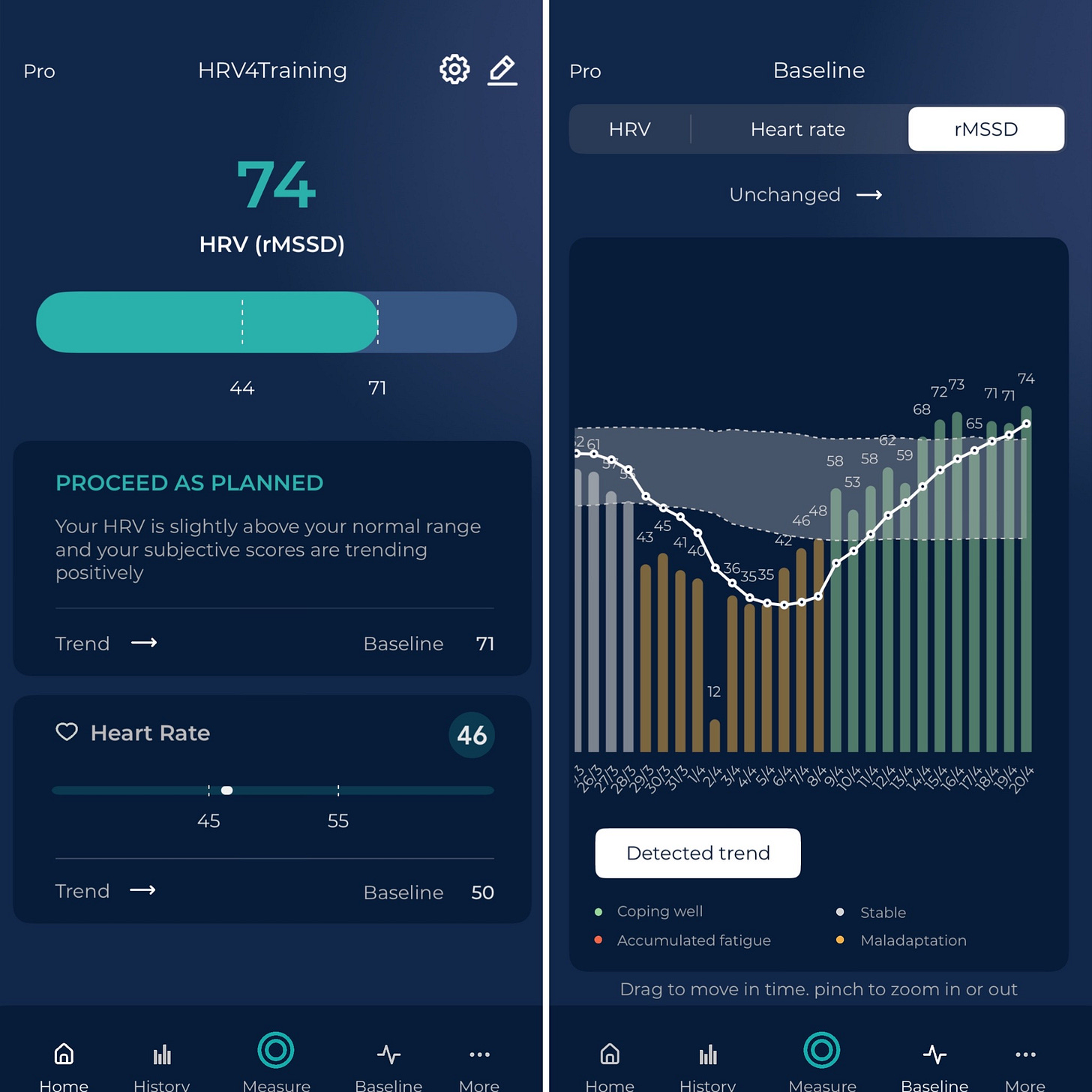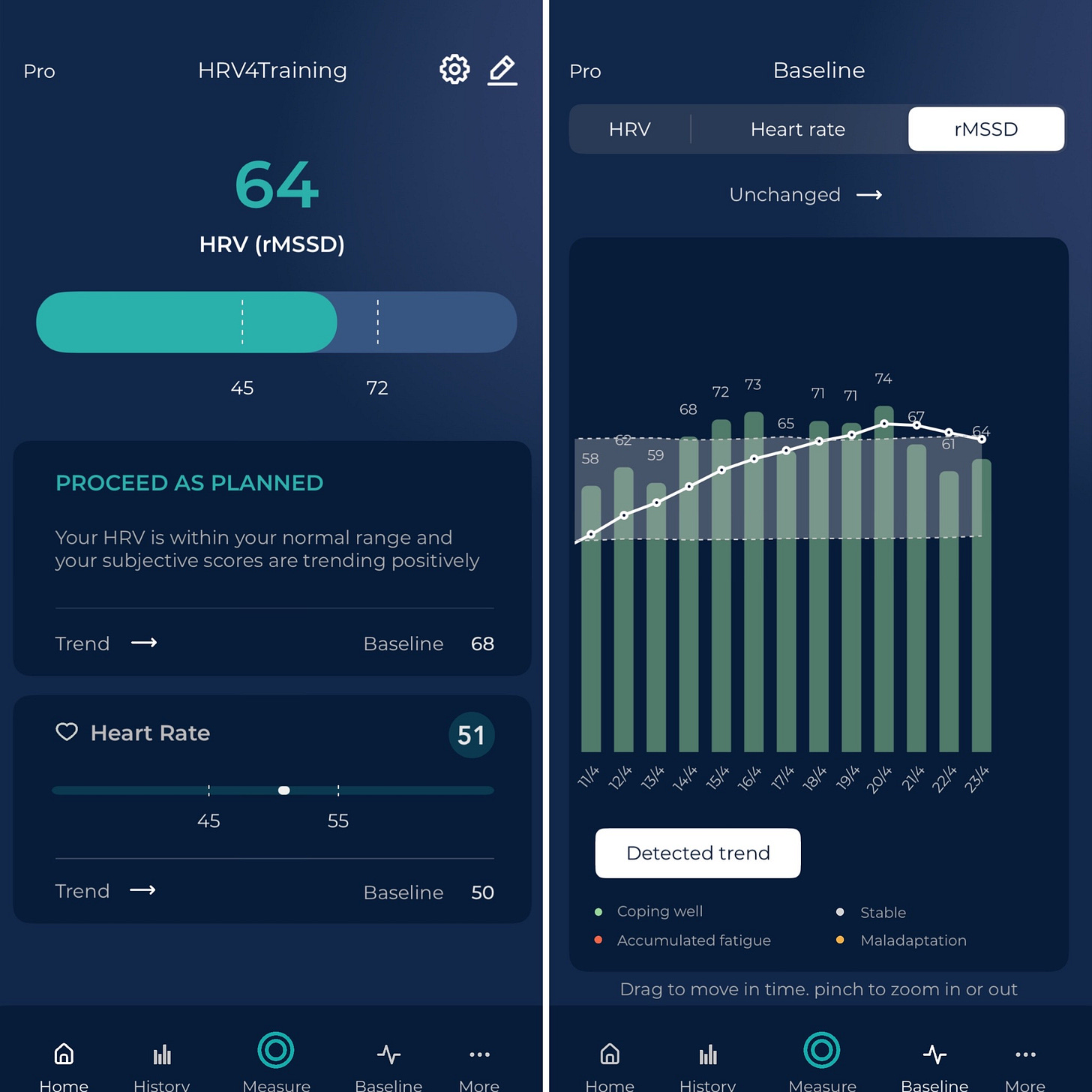Heart Rate Variability (HRV) and Tapering
Expectations and misconceptions.

In this blog, I’d like to cover a common misconception about HRV and tapering, i.e., that your HRV should increase as you reduce training load before a race.
In particular, context here matters (as always!), and I’d like to consider two typical cases, also pertinent to how we can use HRV to assess our response to training:
Case 1: We’ve dug a huge hole with training, struggled, went way too deep, and now we really need a month-long taper to get back into somewhat decent conditions.
Case 2: We’ve accounted for recovery on a weekly (or at least microcycle) basis, trained long and hard, but never went too deep.
You can imagine which way I consider good training and which one not so much. These two approaches typically lead to different HRV profiles in the weeks leading up to the race.
In case of overdoing it in training, we tend to have a suppressed HRV, and then we do hope things somewhat re-normalize by the time we race. This makes sense as the load was already having a strong impact on the athlete’s physiology, possibly to a point at which a negative response was already reached. Keep in mind that a reduced HRV doesn’t mean we are training hard; it means we aren’t recovering well and aren’t assimilating the stress we impose on the body, typically leading to reduced performance. This is the case often shown in research when abnormally high training loads are imposed for the purpose of “overloading” the athlete (Flatt et al, Le Meur et al, Iellamo et al.).
It is important to highlight, however, that reduced HRV during increased load is not the response we normally target or hope to see. Increased load, when coping well with training and responding positively, should result in a stable or increased HRV. As a matter of fact, functional overreaching is associated with increased HRV, despite high load (Le Meur et al). After this increase, things change as we taper. Recent studies (Plews et al., Bellenger et al.) have indeed shown reduced HRV with reduced load during tapering. Notably, this reduction in HRV was associated with world-class performance, highlighting how the reduction was not detrimental to performance. Keep in mind that Case 2 above can include situations in which we do big training blocks and try to get to a state of functional overreaching, but we do so while monitoring the athlete’s response (subjective feel, physiological data, etc.) and making adjustments to make sure we are not spiraling into a poor response and ending up with Case 1 (if you don’t know how to navigate that line, get a good coach!).
In terms of the reasons behind the HRV decrease during taper, one could be the reduction in training volume, which might elicit lower blood plasma volume, and therefore decreased stroke volume, and in turn, increase heart rate and reduced HRV (Plews et al.). Another reason for HRV to reduce could be associated with an overly parasympathetic system during the previous periods of high load.
We can see this both in resting physiology and in training physiology. For example, a suppressed heart rate during training is often reported in periods of high load, as shown below, where I used some of my recent data as an example. Coming from a week of sickness, I had an average load week to get things back up to speed, and then did a mini training camp with
, for about 20 hours of running in 6 days as he visited us here in Brisighella:
On the last day, we ran 32 km with 800m of elevation and 45-50 minutes at threshold, pushing hard on long climbs. My heart rate, however, barely reached my threshold heart rate zone for just a few minutes. High training load caused a large suppression in heart rate, in line with the increase in HRV above my normal range, shown later. This change matters because it sets the scene for what is likely to happen later, when we do reduce the load (i.e., physiology re-normalizes and therefore goes into the opposite direction with respect to the typical reduced heart rate and increased HRV).

Similarly, we can see increased HRV during these days. In my own data, coming back from a period of sickness (the large suppression highlighted in orange), I had an overshoot in HRV that was well aligned with the suppressed heart rate during exercise. While my RMSSD values are typically in the 55-65ms range (see also the few days pre-sickness), this past week I was consistently above my normal range:

Once we come from a situation like the one above, and we start our taper, reducing load, resting heart rate and exercise heart rate will tend to renormalize, and the same happens to HRV, which therefore reduces - this is the opposite of what is often claimed (i.e. that HRV should reduce as we rest and taper):
A reduction in HRV following functional overreaching has also been documented in the scientific literature (Bellenger et al.), where HRV remained relatively elevated, but lower than during a previous phase of higher training load, somewhat consistent with the studies previously mentioned.
Below is the same data in HRV4Training Pro:

These cases are quite different from rebounding from a period of suppressed HRV due to a poor response to a previous block of high load.
Takeaways
Positive responses to increased training load should result in stable or increasing HRV. This increase in HRV is associated with a functional overreaching state, which is also reflected in reduced resting heart rate and exercise heart rate.
Following this phase and response, during tapering, we might have a drop in HRV. There could be multiple reasons behind this reduction in HRV, for example, reduced plasma volume due to less aerobic stimulus, or parasympathetic overactivity due to the high load. Needless to say, this reduction has no implications for performance.
On the other hand, If your training has been less than optimal or your HRV has been often below normal, you might see a rebound with tapering, as most likely a reduction in load was long overdue.
All the best for your next race!
References
Flatt, A. A., Hornikel, B., & Esco, M. R. (2017). Heart rate variability and psychometric responses to overload and tapering in collegiate sprint-swimmers. Journal of science and medicine in sport, 20(6), 606–610
Le Meur, Y., Pichon, A., Schaal, K., Schmitt, L., Louis, J., Gueneron, J., … & Hausswirth, C. (2013). Evidence of parasympathetic hyperactivity in functionally overreached athletes. Med Sci Sports Exerc, 45(11), 2061–2071
Iellamo, F., Legramante, J. M., Pigozzi, F., Spataro, A., Norbiato, G., Lucini, D., & Pagani, M. (2002). Conversion from vagal to sympathetic predominance with strenuous training in high-performance world-class athletes. Circulation, 105(23), 2719–2724
Plews, D. J., Laursen, P. B., Stanley, J., Kilding, A. E., & Buchheit, M. (2013). Training adaptation and heart rate variability in elite endurance athletes: opening the door to effective monitoring. Sports medicine, 43(9), 773–781.
Bellenger, C. R., Karavirta, L., Thomson, R. L., Robertson, E. Y., Davison, K., & Buckley, J. D. (2016). Contextualizing parasympathetic hyperactivity in functionally overreached athletes with perceptions of training tolerance. International journal of sports physiology and performance, 11(5), 685–692
How to Show Your Support
No paywalls here. All my content is and will remain free.
As a HRV4Training user, the best way to help is to sign up for HRV4Training Pro.
Thank you for supporting my work.
Endurance Coaching
If you are interested in working with me, please learn more here, and fill in the athlete intake form, here.
Marco holds a PhD cum laude in applied machine learning, a M.Sc. cum laude in computer science engineering, and a M.Sc. cum laude in human movement sciences and high-performance coaching. He is a certified ultrarunning coach.
Marco has published more than 50 papers and patents at the intersection between physiology, health, technology, and human performance.
He is co-founder of HRV4Training, Endurance Coach at Destination Unknown, advisor at Oura, guest lecturer at VU Amsterdam, and editor for IEEE Pervasive Computing Magazine.
Social:




